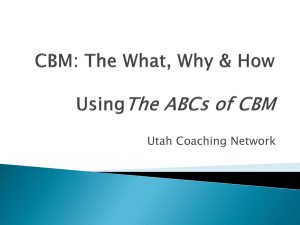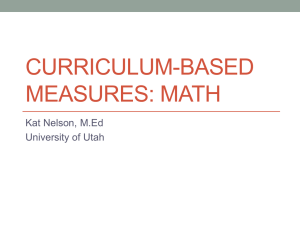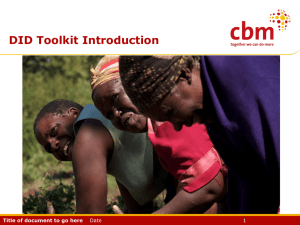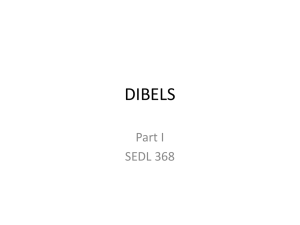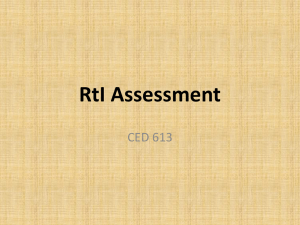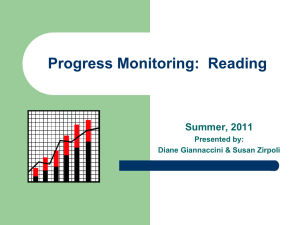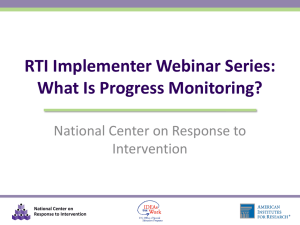Progress Monitoring
advertisement
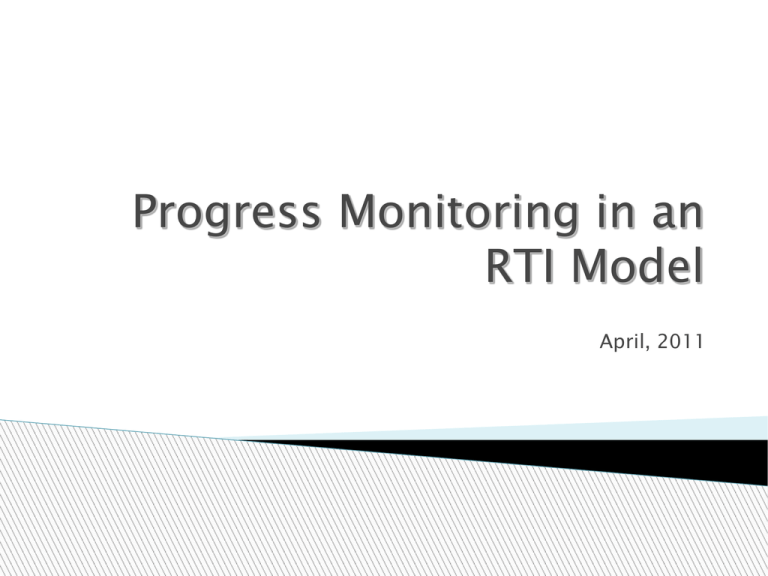
Progress Monitoring in an RTI Model April, 2011 Basic Goal of Assessment • The ultimate goal of assessment is to identify problems with instruction and to lead to instructional modifications. A good share of present-day assessment activities consist of little more than meddling…We must use assessment data to improve instruction…The only way to determine the effectiveness of instruction is to collect data. • Ysseldyke and Algozzine (1995) Curriculum-Based Measurement: Introduction Objectives • • • Learn levels of assessment & associated purposes Increase knowledge and skills in curriculumbased measurement (CBM) Apply knowledge of CBM to diagnostic assessment practices ◦ Learn can’t do/won’t do assessment ◦ Learn survey level assessment Objectives (continued) • • • Learn goal setting formula Apply graphing techniques Analyze data A + B = pC Problem Solving Process Define the Problem Defining Problem/Directly Measuring Behavior Evaluate Response to Intervention (RtI) DATA Implement Plan Implement As Intended Progress Monitor Modify as Necessary Problem Analysis Validating Problem I.D. Variables that Contribute to Problem Develop Plan Response to Intervention RtI is the practice of (1) providing high-quality instruction/intervention matched to student needs and (2) using learning rate over time and level of performance to (3) make important educational decisions (Batsche, et al., 2005) Problem-solving is the process that is used to develop effective instruction/interventions. Anita Archer • Relentless in education • Ability and outcome Formative vs. Summative • “When the cook tastes the soup, that’s formative. When the guests taste the soup, that’s summative.” - Robert Stake Benchmarking & Progress Monitoring What is the difference? • Benchmark: aid in identification of students at-risk; administered 3 times a year (fall, winter, spring) • Progress Monitoring: used to track individual students’ learning, plan instruction, and provide feedback to students; administered weekly or biweekly Why CBM? Benchmarking & Progress Monitoring What is the difference? • Benchmark: aid in identification of students at-risk; administered 3 times a year (fall, winter, spring) • Progress Monitoring: used to track individual students’ learning, plan instruction, and provide feedback to students; administered weekly or biweekly CBM – What is It? • • • • ◦ ◦ ◦ ◦ ◦ ◦ Formative assessment Measure of student performance over time An analysis of specific skill on an individual student Tool Identifying struggling students Set goals Align instruction with desired outcomes Provides diagnostic information Progress monitor IEP development What is the Goal of CBM? • Goal is two-fold: • Monitor student progress 1.Inform instruction / teacher practice Why Should I Do It? • • • • • • Measure of class-wide performance An alternative to other assessment procedures– often replaces costly, timeconsuming, disruptive practices Quick & Easy Establishes reliability & validity Direct low-inference measures Can be easily summarized & presented ◦ Parents, students, colleagues B D I P B D I P Benchmarking - Norms Diagnostic Assessment - Can’t do/Won’t Do - Survey Level Intervention Selection - Standard Treatment (Tier II) - Who, where, frequency, duration, materials Progress Monitoring & Analysis - Data collection - Data Management - Next Steps Assessment and MTSS Tier 3 Tier 2 Tier 1 Adapted from Burns & Riley-Tillman (2010) Assessment and MTSS • Tier III – Identify discrepancy for individual. Identify causal variable. Implement individual intervention. Tier 3 • • Tier 2 Tier II – Identify discrepancy for individual. Identify category of problem. Assign small group solution. Tier I – Identify discrepancy between expectation and performance for class or individual. Tier 1 Adapted from Burns & Riley-Tillman (2010) How Does It Fit Together? Step 1 All students at a grade level Winter Step 3 Additional Diagnostic Assessment Instruction/Int ervention Individual Diagnostic Step 4 Results/Monitoring Individual Instruction Weekly Intensive 5% Universal Screening Fall Step 2 Group Diagnostic Small Group Differentiated by Skill Targeted 15% Spring 2x month None Universal 80% Continue with Core Instruction Benchmarks Grades Classroom Assessments Utah CRT B - Benchmarking • What - An indicator used to identify the expected understandings and skills needed for content standards by grade level - consider norms • When - typically 3x/year - predetermined intervals (e.g., a mid-year benchmark). • Who - all students • How - timed leveled probes What is Reading CBM? • • • • One-minute probe (e.g., DIBELS, 6-min. Solution) Administered individually Provide intervention and progress monitor at instructional level Different measures ◦ Oral Reading Fluency (ORF) ◦ Maze (Comprehension) ◦ Early-reading (Initial Sound, Phoneme Segmentation, Nonsense Word, Letter Naming Fluency) (See Chapters 3 & 4 in ABCs of CBM) Reading CBM - How? • • • • • • • • • Select appropriate material for probe Place probe in front of and facing the student Keep copy for the examiner (on clipboard) Provide directions Start timer Have student perform task for allotted time (1 minute for reading tasks) Score probe Display data on graph/chart Video Clips . . . . Examples QuickTime™ and a YUV420 codec decompressor are needed to see this picture. Scoring Reading Probe • Oral Reading Fluency: ◦ Mark as correct • # of words read correctly in one minute ◦ Mark as incorrect: • Misread words • Omissions • Hesitations - words read by assessor (read after 3 seconds) • Reversals – two or more words not read in order (see page 146 in ABCs of CBM) What is Math CBM? • Math CBM can be broken into three areas: ◦ Early numeracy ◦ Computation ◦ Concepts and Applications • Focus will be on administering, scoring, and using CBM for Computation Math CBM-How? • Math CBM is conducted having students answer computational problems for two minutes Count correct digits – NOT correct problems Use standardized procedures Have necessary materials ◦ ◦ ◦ ◦ ◦ ◦ Different but equivalent math sheets Directions for administration Writing utensils Stopwatch Quiet environment Scoring rules & procedures • • • Math CBM-How? (cont) • • • • • • • Select appropriate material for probe Place probe in front of and facing the student Can be administered individually or as an entire class Provide directions Start timer Have student perform task for allotted time (2 minutes for math tasks) Score probe Curriculum-Based Measurement: Introduction Administration Practices • First time administration ◦ Have three equivalent math sheets ◦ Recommend doing it in one session ◦ Median score of three samples used for baseline (first data point on graph) • Every time ◦ ◦ ◦ ◦ Standardized procedures (see pg 156) Count correct digits Record on graph Use for decision making Scoring Procedures • Correct answers . . . ◦ ◦ ◦ ◦ Correct Correct Correct Correct • Errors answers gets credit for longest method used digits for unfinished problem digits for reversed or rotated digits digits for placeholder – any symbol! ◦ Mark with slash (/) Expected Growth Rates & Norms • • • Benchmarks - Table 7.1 (p. 109) Norms – Table 7.3 (p. 111) Growth Rates – Table 7.1 (p. 109) ◦ greater progress is possible • If student doesn’t make adequate progress, it doesn’t mean she lacks the ability to learn math – it means instruction needs to be changed! Math CBM Sheets • • • • Math often has a specific scope & sequence that can vary from state to state, school to school, or curriculum to curriculum Educators often create math sheets linked to the state’s core – progress monitoring aligned with outcome measure! Math sheets should have different problems but equivalent difficulty Can be purchased or created Math Sheets (cont) • • • • Items on sheet not in order presented in curriculum Similar item types are grouped diagonally – assists when looking for patterns in student responses (see page101) Consider mixed vs. single skill Single-skill sheet helpful for short-term planning – used to gain some diagnostic information & assist in decision making CBM – Types & Their Purpose • • • (see page 15) General Outcome Measures (GOMs) – used to sample performance across several goals by using “capstone” tasks that are complex Skills-based Measures (SBMs) – used to screen, progress monitor, & do survey-level assessment where “capstones” not available Mastery Measures (MM) – used on parts of curriculum that contain discrete & easily identified sets of items Diagnostic - Can’t Do/Won’t Do • Purpose ◦ Determine motivation vs. skill deficit • Technique ◦ Administer same probe – add incentive ◦ Timing - Soon after benchmark/screener • Decision Rules • >=15% increase=motivation (Witt & Beck, 1999) • <15% skill deficit • Consider both Diagnostic Survey-Level Assessment Purposes ◦To determine the appropriate instructional placement level for the student. • The highest level of materials that the student can be expected to benefit from instruction. ◦To provide baseline data, or a starting point, for progress monitoring • In order to monitor progress toward a future goal, you need to know how the student is currently performing. Survey Level Assessment-Reading 1. Start with grade level passages/worksheets (probes) 2. Administer 3 separate probes (at same level of difficulty) using standard CBM procedures. 3. Calculate the median score (i.e. the middle). 4. Is the student’s score within instructional range? ◦ Yes - This is the student’s instructional level. ◦ No - If above level (too easy), administer 3 probes at next level of difficulty. ◦ No - If below level (too hard), administer 3 probes at previous level of difficulty. Reading CBM – Tasks by Grade • • • • • Kindergarten – Letter sound fluency (LSF) Grade 1 – Oral reading fluency (ORF) and/or word identification fluency (WIF) Grade 2 – Oral reading fluency (ORF) Grade 3 – Oral reading fluency (ORF) Grade 4+ - Oral reading fluency (ORF) & mazes See Chapters 3 & 4 Reading CBM – Norms & Growth (see pages 47 & 49) • Norms ◦ Compare student’s score to the performance of others in her grade or at her instructional level ◦ Data collected on thousands of students – numbers are very similar • Growth Rates ◦ Provide an indication of the average number of words per week we would expect students to improve ◦ Not necessarily new words - students reading same words at a faster rate each week Survey Level Assessment-Math 1. Start with grade level math worksheets (probes) 2. Administer 3 separate probes (at same level of difficulty) using standard CBM procedures. 3. Calculate the median score (i.e. the middle). 4. Is the student’s score within instructional range? ◦ Yes - This is the student’s instructional level. ◦ No - If above level (too easy), administer 3 probes at next level of difficulty. ◦ No - If below level (too hard), administer 3 probes at previous level of difficulty. Math CBM – Tasks by Grade • • • • • • Grade 1 – Addition, subtraction Grade 2 – Addition, subtraction Grade 3 – Addition, subtraction, multiplication, division Grade 4+ - Multiplication, division All Grades – Mixed-math skills Secondary – consider common assessments based on state or district core What if Student Data Doesn’t Reflect Adequate Growth? • It is our obligation to fix the problem! • We do NOT lower expectations! ◦ Build up prerequisite skills ◦ Increase length of daily lesson ◦ Alter way we respond when error is made “Learning is a result of instruction, so when the rate of learning is inadequate, it doesn’t always mean there is something wrong with the student. It does mean the instruction needs to be changed to better meet the student’s needs.” (p. 47) How Often Should Data Be Collected? Three considerations: ◦ 1. Purpose – screening vs. benchmarking ◦ 2. Importance of task – learning to read vs. learning Roman numerals ◦ 3. Significance of problem – student’s difficulty increases need effective instruction need more frequent monitoring • I - Intervention P - Progress Monitoring How to Set & Graph Goals • 1. End of Year Benchmarks • 2. Norms - Levels of performance • 3. Rate of progress – goal setting ◦ (# of weeks x growth rate) + median baseline = goal •Students with greatest deficits need steepest slopes – more intense & effective interventions CBM – Easy To Display • One of the main benefits of CBM is the data are easily displayed in graphs & charts ◦ Standard Graph for CBM line graph ◦ Vertical axis = skill being measured ◦ Horizontal axis = time or sessions Graphing – What’s Included • • • • • • • • • • • Baseline Y Axis Label X Axis Label Aim Line - Goal Data Points Intervention Line Intervention Line Label Change Line Change Line Label Level of material being used Student demographics Decision Rules: What is a “Good” Response to Intervention? Positive Response Gap is closing Can extrapolate point at which target student(s) will “come in range” of target--even if this is long range Level of “risk” lowers over time Questionable Response Rate at which gap is widening slows considerably, but gap is still widening Gap stops widening but closure does not occur Poor Response Gap continues to widen with no change in rate. Response to Intervention Positive Questionable Performance Expected Trajectory Poor Observed Trajectory Time Decision Rules: Linking RtI to Intervention Decisions Positive Continue intervention with current goal Continue intervention with goal increased Fade intervention to determine if student(s) have acquired functional independence. Decision Rules: Linking RtI to Intervention Decisions Questionable Was intervention implemented as intended? If no - employ strategies to increase implementation integrity If yes Increase intensity of current intervention for a short period of time and assess impact. If rate improves, continue. If rate does not improve, return to problem solving. Dual Discrepancy Decision Rules: Linking RtI to Intervention Decisions Poor Was intervention implemented as intended? If no - employ strategies in increase implementation integrity If yes - Is intervention aligned with the verified hypothesis? (Intervention Design) Are there other hypotheses to consider? (Problem Analysis) Was the problem identified correctly? Dual Discrepancy (Problem Identification) Sample Graph Peer Reading Sight word practice Using Data to Inform Instruction Data Point Analysis – “If-Then Rules” ◦ 3-4 successive data points above the aim line – move on (add “weight”) ◦ 3-4 successive data points below the aim line – change intervention to boost learning ◦ 3-4 successive data points lie around the aim line – make no changes • Graph – Analyze Graph – Analyze Graphing the Data • • • • By hand 5-Clicks in Excel www.InterventionCentral.com www.updc.org ◦ CBM Focus ◦ PM Focus Evidence-Based Education Adapted from Burns & Riley-Tillman (2010) CBM Data & IEP Development • • • • CBM data are an excellent source for writing goals & objectives CBM data provide information on specific student skills (i.e. ORF, math facts) CBM data are sensitive to student improvement CBM data allow teachers to make instruction decisions Planning & Using CBM 10 Steps for using CBM • 1. Who will be using CBM? • 2. Which skills of CBM will be implemented? • 3. What materials will be used? • 4. When will implementation start? • 5. Who will train the staff? • 6. Who will manage the materials? • 7. Who will collect the data? • 8. Where will the data be collected? • 9. Who will manage the data once collected? • 10. How will data be shared? (Checklist for Using CBM – pp. 160-161) Additional Resources • • • • • • • • • • • • • Updc.org The ABC’s of CBM One-Minute Academic Functional Assessment and Interventions: “Can’t” Do It…or “Won’t” Do It? Functional Assessments: A Step-by-Step Guide to Solving Academic and Behavior Problems Implementing Response-to-Intervention in Elementary and Secondary Schools (Burns & Gibbons, 2008) I’ve DIBEL’d, Now What? AIMSweb.com Interventioncentral.org Pre-Referral Intervention Manual School Problem Solving Teams What Works Clearinghouse: http: //ies.ed.gov/ncee/wwc/ www.Studentprogress.org www.CBMnow.org
